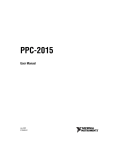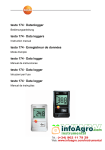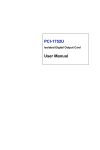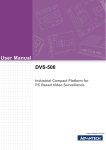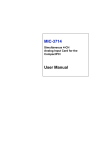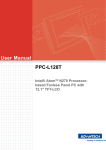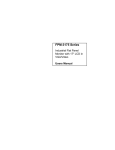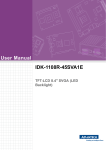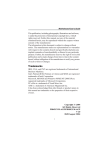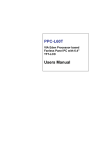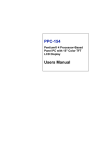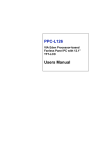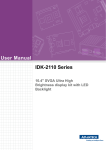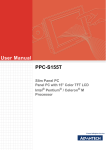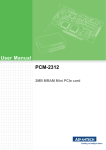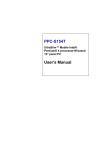Download PPC-174T Manual_ed1.book - Fairchild Engineering Ltd
Transcript
PPC-174T Pentium® 4 processor-based panel PC with 17" TFT-LCD User’s Manual Copyright This document is copyrighted, © 2003. All rights are reserved. The original manufacturer reserves the right to make improvements to the products described in this manual at any time without notice. No part of this manual may be reproduced, copied, translated or transmitted in any form or by any means without the prior written permission of the original manufacturer. Information provided in this manual is intended to be accurate and reliable. However, the original manufacturer assumes no responsibility for its use, nor for any infringements upon the rights of third parties that may result from such use. Acknowledgements Award is a trademark of Award Software International, Inc. VIA is a trademark of VIA Technologies, Inc. IBM, PC/AT, PS/2 and VGA are trademarks of International Business Machines Corporation. Intel and Pentium are trademarks of Intel Corporation. Microsoft Windows® is a registered trademark of Microsoft Corp. RTL is a trademark of Realtek Semi-Conductor Co., Ltd. ESS is a trademark of ESS Technology, Inc. UMC is a trademark of United Microelectronics Corporation. SMI is a trademark of Silicon Motion, Inc. Creative is a trademark of Creative Technology LTD. All other product names or trademarks are properties of their respective owners. For more information on this and other Advantech products, please visit our websites at: http://www.advantech.com http://www.advantech.com/ppc For technical support and service, please visit our support website at: http://support.advantech.com This manual is for the PPC-174T. PPC-174T User’s Manual Part No. 2008017400 1st Edition Printed in Taiwan September. 2003 ii FCC Class B This equipment has been tested and found to comply with the limits for a Class B digital device, pursuant to Part 15 of the FCC Rules. These limits are designed to provide reasonable protection against harmful interference when the equipment is operated in a residential environment. This equipment generates, uses and can radiate radio frequency energy. If not installed and used in accordance with this user's manual, it may cause harmful interference to radio communications. Note that even when this equipment is installed and used in accordance with this user's manual, there is still no guarantee that interference will not occur. If this equipment is believed to be causing harmful interference to radio or television reception, this can be determined by turning the equipment on and off. If interference is occurring, the user is encouraged to try to correct the interference by one or more of the following measures: • Reorient or relocate the receiving antenna • Increase the separation between the equipment and the receiver • Connect the equipment to a power outlet on a circuit different from that to which the receiver is connected • Consult the dealer or an experienced radio/TV technician for help Warning! Any changes or modifications made to the equipment which are not expressly approved by the relevant standards authority could void your authority to operate the equipment. iii Packing List Before you begin installing your card, please make sure that the following materials have been shipped: • PPC-174T series panel PC • User's manual • Accessories for PPC-174T - Power cord (1.8 m) - USA type (other types are available on request) - Floppy disk with CD-ROM drive driver - "Drivers and Utilities" CD-ROM disc - Mounting kits and packet of screws Heat sink (optional) (refer to Notes 1 and 2 below) If any of these items are missing or damaged, contact your distributor or sales representative immediately. Note1: If the unit you have bought is basic (i.e. without a CPU, HDD, or SDRAM), you will find this optional item in the accessory box. Note2: If you install an Intel®processor yourself, you must install a heat sink above the CPU. This will avoid heat damage to the CPU. PPC-174T User’s Manual iv Additional Information and Assistance Step 1. Visit the Advantech web site at www.advantech.com where you can find the latest information about the product. Step 2. Contact your distributor, sales representative, or Advantech's customer service center for technical support if you need additional assistance. Please have the following information ready before you call: • Product name and serial number • Description of your peripheral attachments • Description of your software (operating system, version, application software, etc.) • A complete description of the problem • The exact wording of any error messages Warning! 1. Input voltage rated 100-250 VAC, 50/60 Hz, 3A 2. Use a 3 V @ 195 mA lithium battery 3. Packing: please carry the unit with both hands, handle with care 4. Maintenance: to properly maintain and clean the surfaces, use only approved products or clean with a dry applicator 5. CompactFlash: Turn off power before inserting or removing CompactFlash storage card. Contact information: Our European representative: Advantech Europe GmbH Kolberger Straße 7 D-40599 Düsseldorf, Germany Tel: 49-211-97477350 Fax: 49-211-97477300 v Safety Instructions 1. Read these safety instructions carefully. 2. Keep this User's Manual for later reference. 3. Disconnect this equipment from any AC outlet before cleaning. Use a damp cloth. Do not use liquid or spray detergents for cleaning. 4. For plug-in equipment, the power outlet socket must be located near the equipment and must be easily accessible. 5. Keep this equipment away from humidity. 6. Put this equipment on a reliable surface during installation. Dropping it or letting it fall may cause damage. 7. The openings on the enclosure are for air convection. Protect the equipment from overheating. DO NOT COVER THE OPENINGS. 8. Make sure the voltage of the power source is correct before connecting the equipment to the power outlet. 9. Position the power cord so that people cannot step on it. Do not place anything over the power cord. 10. All cautions and warnings on the equipment should be noted. 11. If the equipment is not used for a long time, disconnect it from the power source to avoid damage by transient overvoltage. 12. Never pour any liquid into an opening. This may cause fire or electrical shock. 13. Never open the equipment. For safety reasons, the equipment should be opened only by qualified service personnel. 14. If one of the following situations arises, get the equipment checked by service personnel: a. The power cord or plug is damaged. b. Liquid has penetrated into the equipment. c. The equipment has been exposed to moisture. d. The equipment does not work well, or you cannot get it to work according to the user's manual. e. The equipment has been dropped and damaged. f. The equipment has obvious signs of breakage. 15. DO NOT LEAVE THIS EQUIPMENT IN AN ENVIRONMENT WHERE THE STORAGE TEMPERATURE MAY GO BELOW -20° C (-4° F) OR ABOVE 60° C (140° F). THIS COULD DAMAGE THE EQUIPMENT. THE EQUIPMENT SHOULD BE IN A CONTROLLED ENVIRONMENT. 16. CAUTION: DANGER OF EXPLOSION IF BATTERY IS INCORRECTLY REPLACED.REPLACE ONLY WITH THE SAME OR EQUIVALENT TYPE RECOMMENDED BY THE MANUFACTURER, DISCARD USED BATTERIES ACCORDING TO THE MANUFACTURER'S INSTRUCTIONS. The sound pressure level at the operator's position according to IEC 704-1:1982 is no more than 70 dB (A). DISCLAIMER: This set of instructions is given according to IEC 704-1. Advantech disclaims all responsibility for the accuracy of any statements contained herein. PPC-174T User’s Manual vi Wichtige Sicherheishinweise 1. Bitte lesen sie Sich diese Hinweise sorgfältig durch. 2. Heben Sie diese Anleitung für den späteren Gebrauch auf. 3. Vor jedem Reinigen ist das Gerät vom Stromnetz zu trennen. Verwenden Sie Keine Flüssig-oder Aerosolreiniger. Am besten dient ein angefeuchtetes Tuch zur Reinigung. 4. Die NetzanschluBsteckdose soll nahe dem Gerät angebracht und leicht zugänglich sein. 5. Das Gerät ist vor Feuchtigkeit zu schützen. 6. Bei der Aufstellung des Gerätes ist auf sicheren Stand zu achten. Ein Kippen oder Fallen könnte Verletzungen hervorrufen. 7. Die Belüftungsöffnungen dienen zur Luftzirkulation die das Gerät vor überhitzung schützt. Sorgen Sie dafür, daB diese Öffnungen nicht abgedeckt werden. 8. Beachten Sie beim. AnschluB an das Stromnetz die AnschluBwerte. 9. Verlegen Sie die NetzanschluBleitung so, daB niemand darüber fallen kann. Es sollte auch nichts auf der Leitung abgestellt werden. 10. Alle Hinweise und Warnungen die sich am Geräten befinden sind zu beachten. 11. Wird das Gerät über einen längeren Zeitraum nicht benutzt, sollten Sie es vom Stromnetz trennen. Somit wird im Falle einer Überspannung eine Beschädigung vermieden. 12. Durch die Lüftungsöffnungen dürfen niemals Gegenstände oder Flüssigkeiten in das Gerät gelangen. Dies könnte einen Brand bzw. elektrischen Schlag auslösen. 13. Öffnen Sie niemals das Gerät. Das Gerät darf aus Gründen der elektrischen Sicherheit nur von authorisiertem Servicepersonal geöffnet werden. 14. Wenn folgende Situationen auftreten ist das Gerät vom Stromnetz zu trennen und von einer qualifizierten Servicestelle zu überprüfen: a - Netzkabel oder Netzstecker sind beschädigt. b - Flüssigkeit ist in das Gerät eingedrungen. c - Das Gerät war Feuchtigkeit ausgesetzt. d - Wenn das Gerät nicht der Bedienungsanleitung entsprechend funktioniert oder Sie mit Hilfe dieser Anleitung keine Verbesserung erzielen. e - Das Gerät ist gefallen und/oder das Gehäuse ist beschädigt. f - Wenn das Gerät deutliche Anzeichen eines Defektes aufweist. 15. VOSICHT: Explisionsgefahr bei unsachgemaben Austausch der Batterie.Ersatz nur durch densellben order einem vom Hersteller empfohlenemahnlichen Typ. Entsorgung gebrauchter Batterien navh Angaben des Herstellers. Der arbeitsplatzbezogene Schalldruckpegel nach DIN 45 635 Teil 1000 beträgt 70dB(A) oder weiger. DISCLAIMER: This set of instructions is given according to IEC704-1. Advantech disclaims all responsibility for the accuracy of any statements contained herein. vii PPC-174T User’s Manual viii Contents Chapter 1 General Information ........................................2 1.1 1.2 1.3 1.4 Chapter Introduction ....................................................................... 2 General specifications ....................................................... 3 PPC-174T LCD Specifications ......................................... 7 Dimensions........................................................................ 8 2 System Setup...................................................10 2.1 2.2 2.3 A Quick Tour of the Panel PC ........................................ 10 Preparing for First-time Use............................................ 12 Installation Procedures .................................................... 12 2.3.1 2.3.2 2.3.3 2.4 2.5 2.6 Chapter Connecting the power cord ........................................... 12 Connecting the keyboard and mouse ............................ 13 Switch on the power ..................................................... 13 Running the BIOS setup program ................................... 13 Installing the system software ......................................... 13 Installing the drivers........................................................ 14 3 Jumper Setting and Connectors ...................18 3.1 Jumpers and Connectors.................................................. 18 3.1.1 3.1.2 3.1.3 3.1.4 3.1.5 Setting Jumpers............................................................. 18 Jumpers and switches.................................................... 19 Table 3.1:Jumpers and their functions.......................... 19 Locations of jumpers .................................................... 19 Connectors .................................................................... 20 Table 3.2:Panel PC connectors ..................................... 20 Locations of connectors ................................................ 21 3.2 CPU installation .............................................................. 21 3.3 Clear CMOS ................................. 22 3.4 COM-port interface ......................................................... 23 Table 3.3:FSB setting (JP1) .......................................... 21 Table 3.4:Clear CMOS/External RTC (JP3) ................ 22 3.4.1 3.4.2 3.5 VGA interface ................................................................. 24 3.5.1 Chapter COM2 RS-232/422/485 setting (JP4)........................... 23 Table 3.5:COM2 RS-232/422/485 setting .................... 23 COM1/COM2/COM3/ pin 9 output setting (JP5) ........ 24 Table 3.6:COM1/2/3 pin 9 output setting(JP5) ............ 24 LCD panel power setting .............................................. 25 Table 3.7:LCD voltage setting (JP2) ............................ 25 4 Hardware Installation and upgrading .........28 4.1 4.2 Jumpers and Connectors.................................................. 28 CPU Installation .............................................................. 28 1 Table of Contents 4.3 4.4 Installing the DDR SDRAM memory module................ 31 Installing the 3.5” Hard Disk Drive (HDD) .................... 32 Appendix A Pin Assignments .............................................36 A.1 ATX Power connector 1 (CN1) .................................... 36 A.2 ATX power connector 2 (CN2)....................................... 37 A.3 LVDS connector 1(CN4) ................................................ 37 A.4 LVDS connector 2(CN6) ................................................ 38 A.5 Inverter power connector (CN5) ..................................... 38 A.6 FDD connector (CN10)................................................... 39 A.7 Touchscreen interface (CN13) ........................................ 40 A.8 Internal speaker connector (CN16) ................................. 40 A.9 Front panel control connector (CN25) ............................ 41 A.10 IR connector (CN26)....................................................... 41 A.11 Fan power connector (FAN1 & FAN2) .......................... 42 Table A.1:AT Power connector 1 (CN1)...................... 36 Table A.2:ATX power connector 2 (CN2) ................... 37 Table A.3:LVDS connector 1(CN4)............................. 37 Table A.4:Table B.4: LVDS connector 2 (CN6) .......... 38 Table A.5:Inverter power connector (CN5).................. 38 Table A.6:FDD connector (CN10) ............................... 39 Table A.7:Touchscreen interface (CN13)..................... 40 Table A.8:Internal speaker connector (CN16).............. 40 Table A.9:Front panel control connector (CN25)......... 41 Table A.10:IR connector (CN26) ................................. 41 Appendix B Programming the Watchdog Timer .............44 B.1 Programming the Watchdog Timer................................. 44 PPC-174T User’s Manual 2 CHAPTER 1 General Information This chapter gives background information on the PPC-174T panel PC. Sections include: • Introduction • General specifications • LCD specifications • Dimensions Chapter 1 General Information 1.1 Introduction The PPC-174T panel PC is a multimedia Pentium® 4 processor-based computer that is designed as a human machine interface (HMI) and desktop computer. It is a PC-based system with 17" color TFT LCD display, on-board PCI Ethernet controller, multi-COM port interfaces and a 16-bit stereo audio controller. With a built-in CD-ROM drive, floppy drive and PCMCIA expansion sockets, the PPC-174T is as compact and userfriendly as a notebook computer. Unlike notebook computers, the PPC174T is more durable and versatile in all applications. The panel PC can be placed on a desktop to replace the traditional desktop computer. In addition, its flexible design can be installed in any environment. It can be wall mounted, panel mounted or placed upright on a desktop. For system integrators, this simple, complete, compact and highly integrated multimedia system lets you easily build a panel PC into your applications. Common industrial applications include factory automation systems, precision machinery, and production process control. It is also suitable for many non-industrial applications, including interactive kiosk systems, entertainment management, and car park automation. Our panel PC is a reliable, cost-effective solution to your application's processing requirements. PPC-174T User’s Manual 2 1.2 General specifications General • Dimensions (W x H x D): 446 x 382 x127 mm (17.56"x15.04"x5") • Weight: 10.5 kg (23 lb) • Power supply: 200 watts Input voltage: 115 VAC / 4A ~ 230VAC / 2A @ 50 ~ 60 Hz Output voltage (Max.): +3.3V@16A, +5 V @ 12 A, +12 V @ 12 A, -12V@ 0.8A, +5VSB@2A • Cooling fan dimensions (L x W x H): 60 x 60 x 20 mm (2.4" x 2.4" x 0.8") • Disk drive housing: Space for one 2.5" HDD, one 12.7 mm compact CD-ROM drive, and one slim type 3.5" FDD • Front panel: IP65 protection (not for the model with SAW touchscreen) Standard PC functions • CPU: Intel® Pentium® 4 or Celeron™ up to 3.06GHz • BIOS: Award 256KB Flash BIOS, supports Plug & Play, APM • Chipset: Intel 845GV • 2nd level cache: On-die 256 or 512KB • RAM: two 184-pin DDR DIMM sockets up to 2GB DDR SDRAM • PCI bus master IDE interface: Supports two connectors. Each connector has one channel and supports two IDE devices. Each channel supports PIO modes 0 ~ 4, DMA mode 0 ~ 2, and Ultra DMA 33/66/ 100 simultaneously. The secondary connector is designated for the CDROM drive. BIOS supports IDE CD-ROM boot-up • Floppy disk drive: Supports up to two FDDs (720 KB / 1.44 MB). One built-in FDD included inside FDD housing • Parallel port: One parallel port, supports SPP/EPP/ECP parallel mode. BIOS configurable to LPT1, LPT2, LPT3 or disabled • Serial ports: Three serial ports with three RS-232 ports (COM1 and 3), one RS-232/422/485 port (COM2). All ports are compatible with 16C550 UARTs • Universal serial bus (USB) port: Supports up to four USB v2.0 ports 3 Chapter 1 • PCI/ISA bus expansion slot: Accepts two PCI bus • Watchdog timer: 63-level, interval 1 ~ 63 seconds. Automatically generates system reset or IRQ11 when the system stops due to a program error or EMI. Jumperless selection and software enabled/disabled • Battery: 3.0 V @ 195 mA lithium battery AGP SVGA /Flat panel interface • Chipset: Integrated in Intel 845GV • Display memory: 8 MB share main memory • Dynamic Video Memory: If the system memory is bigger or equal to 256MB, the video memory will be set to 64MB. If the system memory is between 128MB to 256MB, the video memory will be set to 32MB • Display type: Simultaneously supports CRT and flat panel displays (EL, LCD and gas plasma) • Display resolution: Supports non-interlaced CRT and TFT LCD displays up to 1024 x 768 @ 256K Audio function • Chipset: Integrated in Intel 845GV south bridge • Audio controller: AC97 Ver. 2.0 compliant interface, Multi stream, Direct sound and Direct Sound 3D acceleration • Stereo sound: 18-bit full-duplex codec • Audio interface: Microphone-in, Line-in, Line-out and Game ports (MPU-401) PCI bus Ethernet interface • Chipset: Intel RC82540Em local bus Ethernet controller • Ethernet interface: Full compliance with IEEE 802.3u 100Base-T and 10 Base-T specifications. Includes software drivers and boot ROM 100/10Base-T auto-sensing capability • Wake-on-LAN: Supports wake-on-LAN function with ATX power control PPC-174T User’s Manual 4 Touchscreen (optional) Type Analog Resistive Capacitive SAW Resolution Continuous 1024 x 1024 4096 x 4096 Light Transmission 75% 85% 91% Controller RS-232 interface RS-232 interface RS-232 interface Power Consumption +5 V @ 200 mA +5 V @ 100 mA +5 V @ 150 mA Software Driver Supports DOS, Windows 3.1, Windows 95/98/ME/2000/XP 5 Chapter 1 Optional modules • CPU: Supports Intel® Pentium® 4 or Celeron™ up to 3.06GHz • Memory: Supports up to 2GB DDR SDRAM • HDD: 3.5” Hard disk (The height limitation of the HDD is 1” (25.4mm)) • Touchscreen: Resistive, Capacitive and SAW • CD-ROM drive: 24X or above • DVD-ROM drive: 6X or above • PCMCIA interface: Complies with 1995 PCMCIA card standard. Supports two PCMCIA card/CardBus slots. Two sockets support both a 16-bit PCMCIA card and a 32-bit CardBus simultaneously. Hot insertion and removal. • CF (Compact Flash) & Card Reader interface. Note: The PCMCIA driver of Windows 95 which includes a PCMCIA interface is available on the "Drivers and Utilities" CD-ROM of your PPC-174T package. Environment • Temperature: 0 ~ 45° C (32 ~ 122° F) • Relative humidity: 10 ~ 95% @ 40° C (non-condensing) • Shock: 10 G peak acceleration (11 msec duration) • Power MTBF: 100,000 hrs • Certification: EMC: CE, FCC Class B, BSMI, VCCI • Safety: CE, CAS, UL, CB PPC-174T User’s Manual 6 1.3 PPC-174T LCD Specifications Display type: 17” TFT LCD Max. resolution: 1280 x 1024 Colors: 256 K or above Dot size (mm): 0.264 x 0.264 Viewing angle: 140° Luminance: 250 cd/m2 Temperature: 0 ~ 50° C Simultaneous mode: Yes LCD MTBF: 50,000 hours Backlight MTBF: 25,000 hours * The VR control is defined by hot key in DOS or BIOS mode as below : Ctrl+Alt+F3, Ctrl+Alt+F4 Note: The color LCD display installed in the panel PC is high-quality and reliable. However, it may contain a few defective pixels which do not always illuminate. With current technology, it is impossible to completely eliminate defective pixels. Advantech is actively working to improve this technology. 7 Chapter 1 1.4 Dimensions Units: mm Figure 1.1: Dimensions of the PPC-174T PPC-174T User’s Manual 8 CHAPTER 2 System Setup This chapter details system setup on the PPC-174T panel PC. Sections include: • A Quick Tour of the Panel PC • Preparing for First-time Use • Installation Procedures • Running the BIOS Setup Program • Installing System Software • Installing the Drivers Chapter 2 System Setup 2.1 A Quick Tour of the Panel PC Before you set up the panel PC, take a moment to familiarize yourself with the locations and purpose of the controls, drives, connectors and ports, which are illustrated in the figures below. When you place the panel PC upright on the desktop, its front panel appears as shown in Figure 2-1. Figure 2.1: Front view of PPC-174T panel PC PPC-174T User’s Manual 10 When you look at the left side of the panel PC, you will see the floppy disk drive, CD-ROM drive and PCMCIA expansion sockets, as shown in Fig. 2-2. • CD-ROM eject button Cardreader (optional) •• CD-ROM activity light Compact CD-ROM drive • Floppy eject button Floppy Drive FDD activity light • • • • •• CF card socket (optional) PCMCIA socket PCMCIA eject button Figure 2.2: Left side view of the panel PC When you turn the panel PC around and look at its rear cover, you will find the sunken I/O section at the bottom of the panel PC, as shown in Fig. 2-3. (The I/O section includes various I/O ports, including serial ports, parallel port, Ethernet port, USB ports, microphone jack, and so on.) 11 Chapter 2 PS2 mouse and Keyboard connector Power switch PCI expansion cover Parallel port jack USB ports AC inlet S-video jack • • • • COM ports • • • • • • Ethernet jack VGA port • Microphone jack Line-in jack Line-out jack Figure 2.3: Rear view of the panel PC 2.2 Preparing for First-time Use Before setting up the panel PC system, you should have at least the following items ready: • Power cord (in the accessory box) • Keyboard • Mouse (for system software installation) 2.3 Installation Procedures 2.3.1 Connecting the power cord The panel PC can only be powered through an AC electrical outlet (100 ~ 250 volts, 50 ~ 60 Hz). Be sure to always handle the power cords by holding the plug ends only. Follow these procedures in order: 1. Connect the female end of the power cord to the AC inlet of the panel PC. 2. Connect the 3-pin male plug of the power cord to an electrical outlet. PPC-174T User’s Manual 12 2.3.2 Connecting the keyboard and mouse Connect the PS/2 mouse and keyboard port on the I/O section of the panel PC. 2.3.3 Switch on the power Switch on the power switch on the rear cover. 2.4 Running the BIOS setup program Your panel PC is likely to have been properly set up and configured by your dealer prior to delivery. You may still find it necessary to use the panel PC's BIOS (Basic Input-Output System) setup program to change system configuration information, such as the current date and time or your type of hard drive. The setup program is stored in read-only memory (ROM). It can either be accessed when you turn on or reset the panel PC, by pressing the "Del" key on your keyboard immediately after turning the computer on. The settings you specify with the setup program are recorded in a special area of memory called CMOS RAM. This memory is backed up by a battery so that it will not be erased when you turn off or reset the system. Whenever you turn on the power, the system reads the settings stored in CMOS RAM and compares them to the equipment check conducted during the power on self-test (POST). If an error occurs, an error message will be displayed on screen, and you will be prompted to run the setup program. 2.5 Installing the system software Recent releases of operating systems include setup programs which automatically load and guide you through hard disk preparation and operating system installation. The following guidelines will help you determine the necessary steps in installing your operating system on the panel PC hard drive. If required, insert your operating system's installation or setup diskette into the diskette drive until the release button pops out. The BIOS of the panel PC supports system boot-up directly from the CDROM drive. You may also insert your system installation CD-ROM into the CD-ROM drive. Turn on your panel PC or reset the system by pressing the "Ctrl"+"Alt"+"Del" keys simultaneously. The panel PC will automatically load the operating system from the diskette or CD-ROM. If you are 13 Chapter 2 presented with the opening screen of a setup or installation program, follow the instructions on screen. The setup program will guide you through preparation of your hard drive, and installation of the operating system. If you are presented with an operating system command prompt, such as A:\>, then you must partition and format your hard drive, and manually copy the operating system files to it. Refer to your operating system user's manual for instructions on partitioning and formatting a hard drive. 2.6 Installing the drivers After installing your system software, you will be able to set up the Ethernet, VGA, audio, PCMCIA and touchscreen functions. All the drivers, except for the CD-ROM drive driver, are stored in a CD-ROM disc entitled "Drivers and Utilities." The CD-ROM drive driver is stored in a floppy disk. Both CD-ROM and floppy disk can be found in your accessory box. To set up the CD-ROM function, insert the floppy disk with the CD-ROM drive driver into the floppy disk drive and type "install" after the following prompt is displayed on screen: A: > INSTALL Press "Enter", and the installation process will be completed in a few seconds. The various drivers and utilities in the CD-ROM disc have their own text files to help users install the drivers and understand their functions. These files are useful supplement to the information in this manual. Note: The drivers and utilities used for the PPC-174T panel PCs are subject to change without notice. If in doubt, check Advantech's website or contact our application engineers for the latest information regarding drivers and utilities. PPC-174T User’s Manual 14 D: 845G Graphics Driver(VGA driver) ALC202 (Audio driver) Chipset Software (Chipset driver) ICH4 USB2.0 (USB2.0 driver) Intel LAN 6.2 (Ethernet driver) Touchscreen (Touchscreen driver) 15 Chapter 2 PPC-174T User’s Manual 16 CHAPTER 3 Jumper settings and connectors This chapter describes how to set the panel PC hardware, and instructions on setting jumpers and connecting peripherals, switches and indicators. Be sure to read all the safety precautions before you begin the installation procedures. Sections include: • Jumpers and Connectors • CPU Installation • CMOS Clear for External RTC (JP8) • COM-port Interface • VGA Interface Chapter 3 Jumper Setting and Connectors 3.1 Jumpers and Connectors 3.1.1 Setting Jumpers You can configure your panel PC to match the needs of your application by setting jumpers. A jumper is the simplest kind of electrical switch. It consists of two metal pins and a small metal clip (often protected by a plastic cover) that slides over the pins to connect them. To “close” a jumper, you connect the pins with the clip. To “open” a jumper you remove the clip. Sometimes a jumper will have three pins, labeled 1, 2, and 3. In this case, you would connect either pins 1 and 2 or pins 2 and 3. open closed closed 2-3 open closed closed 2-3 A pair of needle-nose pliers may be helpful when working with jumpers. If you have any doubts about hardware configuration for your application, contact your local distributors or sales representatives before you make any changes. PPC-174T User’s Manual 18 3.1.2 Jumpers and switches The motherboard has a number of jumpers that allow you to configure your system to suit your applications. The table below lists the jumpersí functions. Table 3.1: Jumpers and their functions Label Function JP1 FSB (Front Side Bus) setting JP2 LCD voltage setting JP3 Clear CMOS JP4 COM2 RS-232/422/485 setting JP5 COM1/COM2/COM3/COM4 pin 9 output type setting SW1 Panel type setting 3.1.3 Locations of jumpers Figure 3.1: Jumpers on the PPC-174T motherboard 19 Chapter 3 3.1.4 Connectors Onboard connectors link the panel PC to external devices such as hard disk drives or floppy drives. The table below lists the connectorsí function. Table 3.2: Panel PC connectors Label Function CN1 ATX power connector 1 CN2 ATX power connector 2 CN4 LVDS connector 1 CN5 Inverter power connector CN6 LVDS connector 2 CN10 FDD connector CN13 Touchscreen interface CN16 Internal speaker connector CN18 EIDE HDD connector (2.5î HDD) CN19 EIDE HDD connector (3.5î HDD) CN20 CD-ROM connector CN24 USB 5 / USB 6 connector CN25 Power control connector CN26 IR connector FAN1 CPU fan power connector FAN2 System fan power connector PCI1 PCI bus expansion slot PPC-174T User’s Manual 20 3.1.5 Locations of connectors Figure 3.2: Connectors on the PPC-174T motherboard 3.2 CPU installation You can install an Intel® Pentium® III or Celeron™ CPU without setting any frequency ratio or voltage. Table 3.3: FSB setting (JP1) * Decided by CPU Select 100MHz Select 133MHz *Default setting 21 Chapter 3 3.3 Clear CMOS Warning! To avoid damaging the computer, always turn off the power supply before setting ìClear CMOSî. Set the jumper back to ìNormal operationî before turning on the power supply. Table 3.4: Clear CMOS/External RTC (JP3) *Normal Clear CMOS *Default setting PPC-174T User’s Manual 22 3.4 COM-port interface The panel PC provides three serial ports (COM1, 3: RS-232; COM2: RS232/422/485) in one COM port connector. 3.4.1 COM2 RS-232/422/485 setting (JP4) COM2 can be configured to operate in RS-232, RS-422, or RS-485 mode. This is done via JP4. Table 3.5: COM2 RS-232/422/485 setting *RS-232 RS-422 RS-485 *Default setting 23 Chapter 3 3.4.2 COM1/COM2/COM3/ pin 9 output setting (JP5) Table 3.6: COM1/2/3 pin 9 output setting(JP5) *Normal +5 V output +12 V output *Default setting 3.5 VGA interface The panel PC's AGP VGA interface can drive conventional CRT displays. It is also capable of driving a wide range of flat panel displays, including electroluminescent (EL), gas plasma, passive LCD and active LCD displays. PPC-174T User’s Manual 24 3.5.1 LCD panel power setting The panel PC's AGP SVGA interface supports 5 V and 3.3 V LCD displays. The LCD cable already has a built-in default setting. You do not need to adjust any jumper or switch to select the panel power. Table 3.7: LCD voltage setting (JP2) * Select 5V Select 3.3V *Default setting 25 Chapter 3 PPC-174T User’s Manual 26 CHAPTER 4 Hardware Installation and upgrading Chapter 4 Hardware Installation and upgrading 4.1 Jumpers and Connectors The panel PC consists of a PC-based computer that is housed in a metal rear panel and a metal shielding case. Your HDD, SDRAM, power supply, CPU, and so on are all readily accessible by removing the rear panel and shielding case. Any maintenance or hardware upgrades can be easily completed after removing the rear panel and shielding case. Warning: Do not remove the metal rear cover until you have verified that no power is flowing within the panel PC. Power must be switched off and the power cord must be unplugged. Every time you service the panel PC, you should be aware of this. 4.2 CPU Installation The panel PC's central processing unit (CPU) can be upgraded to improve system performance. The panel PC provides one 478-pin ZIF (Zero Insertion Force) socket (Socket 478). The CPU must come with an attached heat sink and CPU fan to prevent overheating. Warning! The CPU may be damaged if operated without a heat sink and a fan. PPC-174T User’s Manual 28 Caution! Always disconnect the power cord from your panel PC when you are working on it. Do not make connections while the power is on as sensitive electronic components can be damaged by the sudden rush of power. Only experienced electronics personnel should open the panel PC. 1. Detach and remove the metal rear cover. 2. Remove the two screws of the bracket on the power supply, and remove it. 3. Remove the three screws of the power supply, and remove it. (shown in Fig. 5-1) 4. Locate the ZIF socket and open it by first pulling the lever sideways away from the socket, then upwards at a 90 degrees angle. 5. 1 Insert the CPU with the correct orientation. 6. Slide the CPU in gently. It should insert easily. If not, pull the lever up a little more and make sure the pins of the CPU correspond with the holes of the socket. DO NOT USE EXCESSIVE FORCE! 7. Press the lever down. The plate will slide across slightly. 8. Pull the two levers of the heat sink bracket up. 9. Connect the CPU fan power cable to the 3-pin connector (FAN1). (shown in Fig. 5-2) 10. Put the thermal paste on the surface of the CPU. Place the heat sink on top of the CPU and fasten it by pulling down the two levers. (shown in Fig. 5-3). 11. Move the power supply to the original position and tighten the three screws. 29 Chapter 4 12. Move the bracket on the power supply to the original position and tighten the two screws. Figure 4.1: Figure 4.2: PPC-174T User’s Manual 30 Figure 4.3: 4.3 Installing the DDR SDRAM memory module You can install from 128 to 1024 MB of DDR SDRAM memory. The panel PC system provides two 184-pin DDR DIMM (Dual Inline Memory Module) socket and supports 2.5 V DDR SDRAM. 1. Detach and remove the metal rear cover. 2. Push the two white eject levers on each side of the DIMM outward until they are separated from the black vertical posts. 3. Insert the memory module into the socket at a 90 degrees angle. (shown in Fig. 5-4) 31 Chapter 4 4. Push the two ejected levers towards the vertical posts at each end of the socket until the module is upright. Figure 4.4: 4.4 Installing the 3.5” Hard Disk Drive (HDD) You can attach one enhanced Integrated Device Electronics (IDE) hard disk drive to the panel PC's internal controller which uses a PCI local-bus interface. The following are instructions for installation: 1. Detach and remove the metal HDD cover. (shown in Fig. 5-5) 2. Detach the HDD bracket and screws. 3. First connect the IDE trransfer board to the HDD, then place the HDD in the HDD bracket. 4. Tighten the IDE transfer board to the HDD bracket; then tighten the screws on the two side brackets (shown in Fig. 5-6) 5. Place the HDD in the HDD bracket, and tighten the screws on the two sides brackets. (shown in Fig. 5-6) 6. Pull the lever in front of the HDD bracket out and insert the HDD bracket into HDD removable bay. (shown in Fig. 5-7) 7. Press the lever down. (shown in Fig. 5-8) PPC-174T User’s Manual 32 8. Put back the metal HDD cover and secure the two screws on it. Figure 4.5: Figure 4.6: 33 Chapter 4 Figure 4.7: Figure 4.8: PPC-174T User’s Manual 34 Appendix Pin Assignments A Appendix A Pin Assignments A.1 ATX Power connector 1 (CN1) Table A.1: AT Power connector 1 (CN1) Pin Signal Pin Signal 1 3.3V 11 3.3V 2 3.3V 12 -12V 3 GND 13 GND 4 5V 14 PS-ON 5 GND 15 GND 6 5V 16 GND 7 GND 17 GND 8 PW-OK 18 -5V 9 5VSB 19 5V 10 12V 20 5V PPC-174T User’s Manual 36 A.2 ATX power connector 2 (CN2) Table A.2: ATX power connector 2 (CN2) Pin Signal Pin Signal 1 GND 3 12V 2 GND 4 12V A.3 LVDS connector 1(CN4) Table A.3: LVDS connector 1(CN4) Pin Signal Pin Signal 1 VDD 11 RXIN2+ 2 VDD 12 RXIN2- 3 GND 13 GND 4 GND 14 RXIN1+ 5 RXIN3+ 15 RXIN1- 6 RXIN3- 16 GND 7 GND 17 RXIN0+ 8 CLK0+ 18 RXIN0- 9 CLK0- 19 DDC_CLK 10 GND 20 DDC_DAT 37 Appendix A A.4 LVDS connector 2(CN6) Table A.4: Table B.4: LVDS connector 2 (CN6) Pin Signal Pin Signal 1 VDD 11 RXIN6+ 2 VDD 12 RXIN6- 3 GND 13 GND 4 GND 14 RXIN5+ 5 CLK1+ 15 RXIN5- 6 CLK1- 16 GND 7 GND 17 RXIN4+ 8 RXIN7+ 18 RXIN4- 9 RXIN7- 19 CONTRAST 10 GND 20 HPLG_DT A.5 Inverter power connector (CN5) Table A.5: Inverter power connector (CN5) Pin Signal 1 +12V 2 GND 3 ENABKL 4 Brightness Adj. 5 +5V PPC-174T User’s Manual 38 A.6 FDD connector (CN10) Table A.6: FDD connector (CN10) Pin Signal Pin Signal 1 Vcc(+5V) 14 Step 2 Index 15 GND 3 Vcc(+5V) 16 Write data 4 Drive select 17 GND 5 Vcc(+5V) 18 Write enable 6 Disk change 19 GND 7 NC 20 Track 0 8 NC 21 GND 9 NC 22 Write protect 10 Motor on 23 GND 11 NC 24 Read data 12 Direction 25 GND 13 Density select 26 Side 1 select 39 Appendix A A.7 Touchscreen interface (CN13) Table A.7: Touchscreen interface (CN13) Pin Signal Pin Signal 1 NRLSD 2 NDSR 3 NRX 4 NRTS 5 NTX 6 NCTS 7 NDTR 8 NRI 9 GND 10 GND 11 MSDAT 12 EXT MSDAT 13 MSCLK 14 EXT MSCLK 15 Vcc 16 Vcc A.8 Internal speaker connector (CN16) Table A.8: Internal speaker connector (CN16) Pin Signal 1 Speaker out_R - 2 Speaker out_R + 3 Speaker out_L + 4 Speaker out_L - PPC-174T User’s Manual 40 A.9 Front panel control connector (CN25) Table A.9: Front panel control connector (CN25) Pin Signal Pin Signal 1 Vcc 2 GND 3 PWRLED(+) 4 PWRLED(-) 5 HDLED(+) 6 HDLED(-) 7 LACTLED(+) 8 LACTLED(-) 9 LINK100LED(+) 10 LINK100LED(-) 11 LINK1000LED(+) 12 LINK1000LED(-) 13 POWERSW(+) 14 POWERSW(-) 15 RESETSW(+) 16 RESETSW(-) A.10 IR connector (CN26) Table A.10: IR connector (CN26) Pin Signal 1 Vcc 2 NC 3 IR_IN 4 GND 5 IR_OUT 41 Appendix A A.11 Fan power connector (FAN1 & FAN2) Table A.11: Fan power connector (FAN1 & FAN2) Pin Signal 1 GND 2 +12V 3 FAN_DET PPC-174T User’s Manual 42 Appendix B Programming the Watchdog Timer The PPC-174T is equipped with a watchdog timer that resets the CPU or generates an interrupt if processing comes to a standstill for any reason. This feature ensures system reliability in industrial standalone or unmanned environments. Appendix B Programming the Watchdog Timer B.1 Programming the Watchdog Timer To program the watchdog timer, you must write a program which writes I/ O port address 440 (hex). The output data is a time interval value. The value range is from 01 (hex) to 3F (hex), and the related time interval is from 1 sec. to 63 sec. Data Time Interval 01 1 sec. 02 2 sec. 03 3 sec. 04 4 sec. ï ï ï ï ï ï 3F 63 sec. After data entry, your program must refresh the watchdog timer by rewriting the I/O port 440 (hex) while simultaneously setting it. When you want to disable the watchdog timer, your program should read I/O port 440 (hex). The following example shows how you might program the watchdog timer : ;----------------------------------------------------------------------------------; Enter the extended function mode , interruptible double-write | ;----------------------------------------------------------------------------------MOV DX,2EH MOV AL,87H OUT DX,AL OUT DX,AL PPC-174T User’s Manual 44 ;----------------------------------------------------------------------------; Configurate logical device 8, configuration register CRF6 | ;----------------------------------------------------------------------------MOV DX,2EH MOV AL,07H ; point to Logical Device Number Reg. OUT DX,AL MOV DX,2FH MOV AL,08H ; select logical device 8 OUT DX,AL ; MOV DX,2EH MOV AL,30H ;Set watch dog activate or inactivate OUT DX,AL MOV DX,2FH MOV AL,01H ; 01:activate 00:inactivate OUT DX,AL ; MOV DX,2EH MOV AL,F5H ; Setting counter unit is second OUT DX,AL MOV DX,2FH MOV AL,00H OUT DX,AL ; MOV DX,2EH MOV AL,F6H OUT DX,AL MOV DX,2FH MOV AL,05H ; Set 5 seconds OUT DX,AL 45 Appendix B ;-----------------------------------------; Exit extended function mode | ;-----------------------------------------MOV DX,2EH MOV AL,AAH OUT DX,AL PPC-174T User’s Manual 46
























































